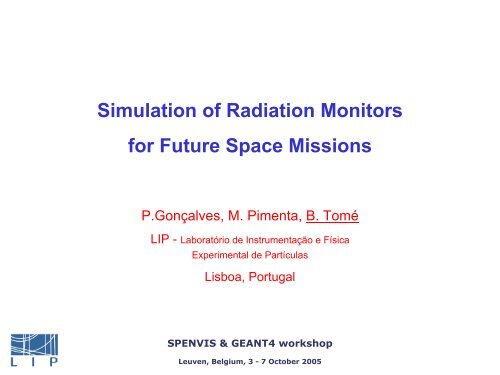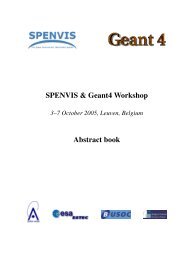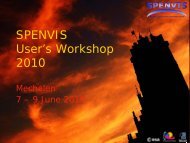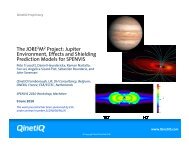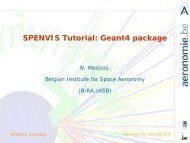Simulation of Radiation Monitors for Future Space Missions - SPENVIS
Simulation of Radiation Monitors for Future Space Missions - SPENVIS
Simulation of Radiation Monitors for Future Space Missions - SPENVIS
Create successful ePaper yourself
Turn your PDF publications into a flip-book with our unique Google optimized e-Paper software.
<strong>Simulation</strong> <strong>of</strong> <strong>Radiation</strong> <strong>Monitors</strong><br />
<strong>for</strong> <strong>Future</strong> <strong>Space</strong> <strong>Missions</strong><br />
P.Gonçalves, M. Pimenta, B. Tomé<br />
LIP - Laboratório de Instrumentação e Física<br />
Experimental de Partículas<br />
Lisboa, Portugal<br />
<strong>SPENVIS</strong> & GEANT4 workshop<br />
Leuven, Belgium, 3 - 7 October 2005
<strong>Space</strong> radiation environment (seen by a non-expert...)<br />
Earth´s trapped radiation belts<br />
Electrons (
Laser Interferometer <strong>Space</strong> Antenna X-ray Evolving Universe Spectroscopy<br />
BH, Galaxy clusters; ISM<br />
Status in develop.<br />
Launch after 2014<br />
ESA +<br />
XEUS<br />
LISA<br />
Gravitational waves<br />
Status in develop.<br />
Launch 2011<br />
ESA + NASA<br />
Earth-like planets<br />
Status in develop.<br />
Launch after 2014<br />
ESA +<br />
BepiColombo<br />
Darwin<br />
Sun's polar regions<br />
Status in develop.<br />
Launch after 2010<br />
ESA +<br />
Solar Orbiter<br />
Gaia<br />
James Webb <strong>Space</strong> Telescope<br />
JWST<br />
Very distant Universe<br />
Status in develop.<br />
Launch 2010<br />
ESA + NASA<br />
Mercury<br />
Status in develop.<br />
Launch 2011-2012<br />
ESA +Japan<br />
Galactic Census<br />
Status in develop.<br />
Launch after 2011<br />
GSC<br />
SOME FUTURE MISSIONS
<strong>Radiation</strong> <strong>Monitors</strong> in <strong>Space</strong> <strong>Missions</strong><br />
Provide ancillary radiation environment in<strong>for</strong>mation <strong>for</strong> the spacecraft<br />
Trigger shielding actions<br />
Data with scientific quality always welcome<br />
<strong>Radiation</strong> Monitor might be the only non dormant instrument during the cruise phase<br />
Data <strong>of</strong> scientific relevance can be acquired during the cruise phase<br />
(e.g. particle fluxes & spectral distributions vs distance to Sun)<br />
Stringent limitations on mass and power budget<br />
New generation compact, lightweight space radiation monitor:<br />
Measure electrons in the range ~ 0.5 MeV – 20 MeV ;<br />
“ protons and ions in the range 0.5 MeV/n – 150 MeV/n ;<br />
Weigh less than 1 Kg, w/ a volume <strong>of</strong> ~ 5 x 5 x 5 cm 3 ;<br />
Have a power consumption less than 1 W ;
An end to end simulation is needed<br />
<strong>Simulation</strong> <strong>of</strong> particle transport from the source to the detector<br />
• description <strong>of</strong> the radiation environment<br />
• modelling injection and propagation <strong>of</strong> particles from the Sun<br />
• scaling <strong>of</strong> SPE fluxes to other planets<br />
Detailed detector simulation<br />
• Interaction <strong>of</strong> incident particles with detector materials.<br />
• Generation & propagation <strong>of</strong> secondary signals (Fluorescence photons,<br />
ionization charges, ...).<br />
• Detection <strong>of</strong> secondaries by readout devices (photodetectors, ... ).<br />
• Integration <strong>of</strong> readout electronics, signal digitization, trigger, ...<br />
• Generation <strong>of</strong> simulated raw data (real data like) <strong>for</strong> further data<br />
processing (pedestal subtraction, calibration, event reconstruction,...) &<br />
Data analysis.<br />
Geant 4 DIGITsim
Geant 4 toolkit<br />
Geant4 is a toolkit <strong>for</strong> the simulation <strong>of</strong> particle transport and interaction<br />
with matter, featuring :<br />
<br />
<br />
<br />
<br />
Description <strong>of</strong> geometries <strong>of</strong> arbitrary complexity.<br />
<strong>Simulation</strong> <strong>of</strong> Hadronic, Electromagnetic and Optical physics processes.<br />
OO design, allowing the implementation <strong>of</strong> flexible simulation applications.<br />
New physics processes categories easily plugged-in (openness & extensibility<br />
<strong>of</strong> the code).
Optical processes in Geant4 – an example:<br />
Refraction<br />
Scintillation<br />
Absorption<br />
Proton<br />
Scintillator<br />
Reflection<br />
+ Cerenkov & Transition radiation, Rayleigh scattering<br />
+ description <strong>of</strong> surface roughness (Unified Model)
DIGITsim - Digitization Module<br />
Set <strong>of</strong> abstract interfaces <strong>for</strong>:<br />
• Detector charge signal simulation<br />
• A/D conversion<br />
• Trigger implementation<br />
• Pulse amplitude and time reconstruction<br />
(Re-use <strong>of</strong> ClearPEM DIGITsim module, based on CMS/ECAL approach)<br />
The electronics configuration is stored in a macro file and can be changed interactively<br />
Example <strong>of</strong> input data:<br />
• QE, bias voltage, gain, current dark noise<br />
• Amplifier electronic noise<br />
• Pulse shape and ADC parameters<br />
• Trigger configuration DIGITsimStoreDigit<br />
OpticalHits ChargeHits Time Pulses ADCDataframes Reco Event<br />
Front-End (Detector/Electronics) DAQ & Trigger Event Reconstruction
A compact, general purpose, radiation monitor concept<br />
(A. Owens et al. (ESA-SCI/A), private communication)<br />
Scintillating Crystal<br />
Tracking planes<br />
Absorber +<br />
tracking<br />
plane<br />
Photodetectors<br />
Main features:<br />
Similar concepts from, e.g.:<br />
• G. Pasquali et. al, NIM A301 (1991)101<br />
• Sensys MRM´s<br />
• <br />
• Particle tracking<br />
• Particle id. through dE/dx in trackers<br />
• Energy measurement in crystal<br />
• Anticoincidence shielding via phoswitching
Si PIN photodiode<br />
3 cm<br />
Q.E. = 100 %<br />
Q.E. = 85% (λ=540 nm)<br />
• High quantum efficiency<br />
• Low voltage<br />
• Low power dissipation<br />
LaBr 3<br />
• Good sensitivity matching w/ CsI, BGO.<br />
NaI(Tl)<br />
BGO<br />
CsI(Tl)
A 10 MeV proton ...<br />
Time spectrum <strong>of</strong> signals in the photodetectors<br />
Scintillation photons<br />
Decay time spectrum <strong>for</strong> CsI (Tl)
A 100 MeV proton ...<br />
Time spectrum <strong>of</strong> signals in the photodetectors<br />
Fast direct ionization<br />
(e.g. in Si PIN diode)<br />
Scintillation photons<br />
Direct ionization and scintillation signals can be disentangled<br />
by real time pulse height analysis.<br />
Veto events not fully contained; energy resolution improved.
Some illustrative results from simulation<br />
Energy deposition in trackers vs incident energy<br />
Energy deposition in crystal vs incident energy
Some illustrative results from simulation (cont.)<br />
Fractional energy deposition in crystal by protons
Concept optimization & developments<br />
<br />
Scintillator<br />
Light yield, emission spectrum, decay time, density,...<br />
CsI (Tl), NaI(Tl), BGO, LSO, LYSO, LuYAP, LaBr 3 ...<br />
<br />
Photodetector<br />
Si photodiode, hybrid photosensor,...<br />
<br />
<br />
Alternative geometries & readout schemes<br />
Study <strong>of</strong> secondaries induced by external mechanical structures<br />
Complex geometries.<br />
Exchange <strong>of</strong> geometrical in<strong>for</strong>mation with CAD systems is crucial.
Concluding:<br />
A new generation <strong>of</strong> compact, lightweight, general purpose<br />
radiation monitors are needed <strong>for</strong> future <strong>Space</strong> <strong>Missions</strong> (e.g.<br />
BepiColombo).<br />
A simple concept based on a scintillating crystal is under study.<br />
LIP will be responsible <strong>for</strong> implementing the required Geant4 based<br />
detector simulations (contract with EFACEC/Portugal).


